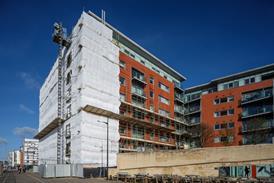The High Court’s ruling in Cooper v Ludgate House Ltd and Powell v Ludgate House Ltd [2025] EWHC 1724 (Ch) offers key guidance for rights of lights disputes in urban developments. Matthew Weal, Hugh Le-Gear and Shanna Davison discuss the court’s approach, and the implications for developers and practitioners


In a landmark decision set to shape the future of rights of light litigation, the High Court has ruled on the long-anticipated case concerning the Arbor building at Bankside Yards, London. The judgment in Cooper v Ludgate House Ltd and Powell v Ludgate House Ltd [2025] EWHC 1724 (Ch) provides critical guidance on the measurement of light interference, the availability of injunctive relief, the assessment of damages and the role of statutory powers under section 203 of the Housing and Planning Act 2016.
Bankside Yards development
The Arbor building, completed in December 2022, is the first of eight buildings forming part of the Bankside Yards regeneration project, approved by Southwark Council in 2014. Designed to deliver net-zero carbon office space across 19 levels, Arbor boasts an ‘excellent’ Building Research Establishment Environmental Assessment Method (BREEAM) rating. However, its construction led to a reduction in natural light for neighbouring flats in Bankside Lofts, prompting claims of rights of light infringement from two flat owners.

While the demolition of buildings previously situated at the development site temporarily improved light conditions for residents, the full impact of the development will only be realised once the remaining seven buildings are completed – potentially over the next 15 years.
The remaining seven buildings proposed in the phased development benefit from section 203 of the Housing and Planning Act 2016. This statutory power permits local authorities to acquire development land and transfer it back to the developer to complete the project, notwithstanding that the development interferes with third party rights over the land, such as rights of light. When these statutory powers are engaged, the neighbouring owners lose the ability to enforce their rights by means of an injunction to prevent the development. Instead, they become entitled to statutory compensation for the interference.
Legal issues and the court’s approach
The case required the court to address several unresolved legal and technical questions.
- Measurement of light: should the century-old Percy Waldram method, which assesses sky visibility at table height, remain the standard? Or should modern ‘radiance’ models, which use computerised data to measure actual light levels, take precedence?
- Impact of section 203: how does land acquisition under section 203 affect the assessment of interference with rights of light for land not acquired under section 203
- Remedies for infringement: if an actionable interference is found, should the court grant an injunction or award damages? What factors should influence this decision?
Measurement of interference
The court rejected the developer’s argument that light received over land subject to section 203 should be included in the assessment. Instead, it held that only protectable light – for example, light that would not be blocked by future development – should be considered.
Mr Justice Fancourt then reaffirmed the validity of the Waldram method for measuring interference: “Waldram remains used and broadly respected by the whole light surveying industry. It has stood the test of time and has the confidence of the industry.”
He considered that newer radiance models, including those measuring median daylight factor and median daylight illuminance, might be useful in unusual or marginal cases. However, he said: “If reliance on the radiance methods ultimately comes down to a subjective and impressionistic assessment of false colour graphical representations of results, rather than the results themselves (as was the case here), then I question the value of that. It amounts to replacing an established, universally applied, agreed standard with the subjective opinion of an expert light surveyor – which was the opposite of what Percy Waldram attempted to do over 100 years ago.”
Refusal of injunction
Applying the principles from Lawrence v Fen Tigers [2014] UKSC 13, the court declined to grant an injunction. Its key considerations included the following:
- the impracticality of enforcing an injunction due to the non-joinder of Arbor’s tenants
- the likelihood that the developer could obtain new planning permission and benefit from section 203 protection, rendering futile any injunction requiring the building to be demolished or cut back
- the public interest in retaining a completed, environmentally sustainable building, and
- the developer’s efforts to engage with claimants and the fact that other affected residents had settled their claims.
The court concluded that the balance of harm weighed against injunctive relief.
Calculation of damages
Rather than calculating damages based on diminution in value, the court adopted a hypothetical negotiation model. It estimated that the developer’s gain from avoiding design cutbacks was approximately £30 million. A reasonable release fee was assessed at 10–15% of this figure, resulting in initial damage estimates of £725,000 and £525,000, respectively, for each of the claimants.
However, after considering the market value of the flats and anticipated compensation under section 203, the court adjusted the awards to £500,000 and £350,000, respectively. This is still believed to be the highest negotiating damages awarded in a rights of light case.
Implications for developers and practitioners
This judgment reinforces a modern judicial trend: damages may be preferred over injunctions where enforcement would be complex, disproportionate or contrary to public interest. While injunctive relief remains a possibility, developers can take encouragement from the court’s pragmatic approach.
The case also highlights the strategic use of section 203 by local authorities to facilitate development, and the importance of early engagement with affected parties. For legal practitioners, the decision offers valuable insights into how courts may assess future rights of light claims, particularly in urban regeneration contexts.
The High Court’s decision in Cooper v Ludgate House Ltd underscores the importance of balancing private property rights against broader public and commercial interests. It also provides clarity over the framework for assessing interference and remedies in complex urban developments. As cities continue to evolve, this judgment will serve as a touchstone for developers, surveyors and legal professionals navigating the shadows cast by modern construction.




















